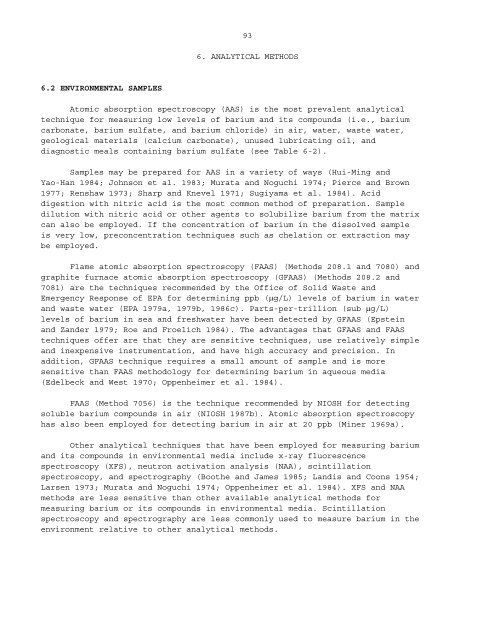TOXICOLOGICAL PROFILE FOR BARIUM AND COMPOUNDS ...
TOXICOLOGICAL PROFILE FOR BARIUM AND COMPOUNDS ...
TOXICOLOGICAL PROFILE FOR BARIUM AND COMPOUNDS ...
You also want an ePaper? Increase the reach of your titles
YUMPU automatically turns print PDFs into web optimized ePapers that Google loves.
93<br />
6. ANALYTICAL METHODS<br />
6.2 ENVIRONMENTAL SAMPLES<br />
Atomic absorption spectroscopy (AAS) is the most prevalent analytical<br />
technique for measuring low levels of barium and its compounds (i.e., barium<br />
carbonate, barium sulfate, and barium chloride) in air, water, waste water,<br />
geological materials (calcium carbonate), unused lubricating oil, and<br />
diagnostic meals containing barium sulfate (see Table 6-2).<br />
Samples may be prepared for AAS in a variety of ways (Hui-Ming and<br />
Yao-Han 1984; Johnson et al. 1983; Murata and Noguchi 1974; Pierce and Brown<br />
1977; Renshaw 1973; Sharp and Knevel 1971; Sugiyama et al. 1984). Acid<br />
digestion with nitric acid is the most common method of preparation. Sample<br />
dilution with nitric acid or other agents to solubilize barium from the matrix<br />
can also be employed. If the concentration of barium in the dissolved sample<br />
is very low, preconcentration techniques such as chelation or extraction may<br />
be employed.<br />
Flame atomic absorption spectroscopy (FAAS) (Methods 208.1 and 7080) and<br />
graphite furnace atomic absorption spectroscopy (GFAAS) (Methods 208.2 and<br />
7081) are the techniques recommended by the Office of Solid Waste and<br />
Emergency Response of EPA for determining ppb (µg/L) levels of barium in water<br />
and waste water (EPA 1979a, 1979b, 1986c). Parts-per-trillion (sub µg/L)<br />
levels of barium in sea and freshwater have been detected by GFAAS (Epstein<br />
and Zander 1979; Roe and Froelich 1984). The advantages that GFAAS and FAAS<br />
techniques offer are that they are sensitive techniques, use relatively simple<br />
and inexpensive instrumentation, and have high accuracy and precision. In<br />
addition, GFAAS technique requires a small amount of sample and is more<br />
sensitive than FAAS methodology for determining barium in aqueous media<br />
(Edelbeck and West 1970; Oppenheimer et al. 1984).<br />
FAAS (Method 7056) is the technique recommended by NIOSH for detecting<br />
soluble barium compounds in air (NIOSH 1987b). Atomic absorption spectroscopy<br />
has also been employed for detecting barium in air at 20 ppb (Miner 1969a).<br />
Other analytical techniques that have been employed for measuring barium<br />
and its compounds in environmental media include x-ray fluorescence<br />
spectroscopy (XFS), neutron activation analysis (NAA), scintillation<br />
spectroscopy, and spectrography (Boothe and James 1985; Landis and Coons 1954;<br />
Larsen 1973; Murata and Noguchi 1974; Oppenheimer et al. 1984). XFS and NAA<br />
methods are less sensitive than other available analytical methods for<br />
measuring barium or its compounds in environmental media. Scintillation<br />
spectroscopy and spectrography are less commonly used to measure barium in the<br />
environment relative to other analytical methods.
















